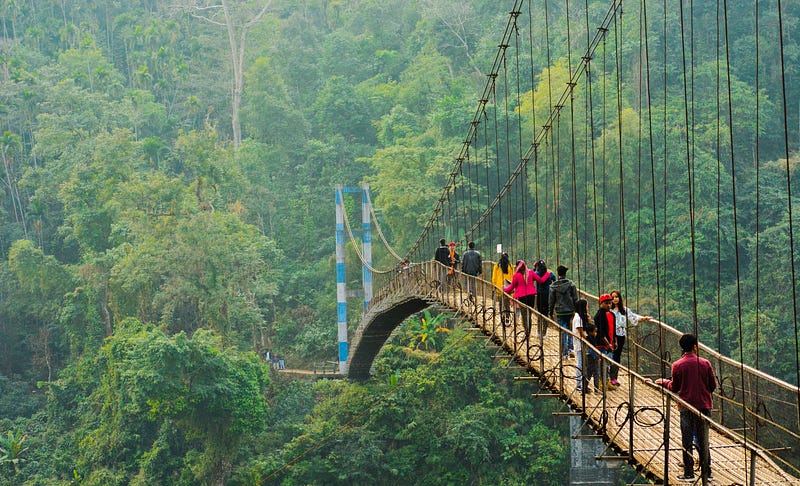In Meghalaya, India, Ancient Forests and Cultures Intertwine

Meghalaya, which translates to “the abode of clouds,” is a land of mist-laden hills, cascading waterfalls, and dense forests. The state is home to a rich tapestry of indigenous communities, each with its own distinct traditions, folklore, and deep-rooted connection to nature. The forests of Meghalaya have not only provided sustenance and shelter to its inhabitants but have also shaped their cultural practices and beliefs.
2. The Enchanting Forests of Meghalaya
2.1 The Living Root Bridges
One of the most captivating features of Meghalaya’s forests is the living root bridges. Constructed by the indigenous Khasi and Jaintia tribes, these unique bridges are formed by guiding the roots of ancient trees across rivers and streams. Over time, the roots grow and strengthen, creating natural and sustainable bridges that can withstand the test of time. These living root bridges are not only functional but also serve as symbols of harmony between humans and nature.
2.2 Sacred Groves
Sacred groves are another remarkable aspect of Meghalaya’s forests. These are patches of land that have been protected and preserved by the indigenous communities as sacred spaces. These groves are believed to be inhabited by deities and spirits and are considered biodiversity hotspots. They serve as natural reservoirs of rare flora and fauna and play a crucial role in maintaining the ecological balance of the region.
2.3 Flora and Fauna
Meghalaya’s forests are incredibly diverse, housing a wide array of plant and animal species. The dense forests are adorned with towering trees, vibrant orchids, and medicinal plants. The region is also home to a variety of wildlife, including elephants, tigers, leopards, and numerous bird species. The forests of Meghalaya are a treasure trove of biodiversity, providing a sanctuary for endangered species and contributing to the overall ecological health of the area.
3. Indigenous Cultures and Forest Traditions
Meghalaya is inhabited by three major indigenous tribes: the Khasi, Garo, and Jaintia tribes. These tribes have a deep reverence for nature and have developed intricate cultural traditions that revolvearound the forests.
3.1 Khasi Tribe
The Khasi tribe, the largest ethnic group in Meghalaya, has a profound connection with the forests. They believe in the concept of “Ka Blei Synshar,” which translates to “God of the Forest.” The Khasi people consider the forests as sacred and believe in the spirit of nature. They practice sustainable agriculture and have a deep understanding of herbal medicine derived from the plants found in the forests.
3.2 Garo Tribe
The Garo tribe, known for their vibrant festivals and folklore, also have a close relationship with the forests. They hold immense respect for nature and believe in the concept of “Sakalnidong,” which means the sacredness of all living beings. The Garo people have traditional farming practices that promote biodiversity and sustainability. They have intricate knowledge of the medicinal properties of various plants and herbs found in the forests.
3.3 Jaintia Tribe
The Jaintia tribe, known for their expertise in coal mining, also have a deep-rooted connection with the forests. They have traditional conservation practices that are based on the concept of “Ka Syngkai,” which means the protection of the environment. The Jaintia people understand the importance of preserving the forests for future generations and actively participate in reforestation efforts.
4. Conservation Efforts and Sustainable Practices
Recognizing the ecological and cultural significance of the forests, Meghalaya has witnessed several conservation efforts and the adoption of sustainable practices.
4.1 Community-led Initiatives
Local communities, along with non-governmental organizations, have taken the lead in protecting the forests of Meghalaya. They have formed community-based organizations and implemented initiatives to conserve the biodiversity and promote sustainable forest management. These efforts involve raising awareness, conducting research, and actively engaging in reforestation activities.
4.2 Traditional Forest Management
The indigenous communities of Meghalaya have centuries-old forest management practices that are based on sustainable principles. These practices include rotational farming, selective logging, and controlled use of forest resources. The tribes have a deep understanding of the forest ecosystems and ensure that their activities do not harm the delicate balance of nature.
4.3 Ecotourism
Meghalaya’s forests have become a significant attraction for ecotourism. Responsible tourism practices are being encouraged to ensure that visitors can appreciate the natural beauty of the forests while minimizing their impact on the environment. Ecotourism initiatives provide economic opportunities for local communities and create incentives for the conservation of the forests.
5. Preserving the Legacy for Future Generations
The preservation of Meghalaya’s ancient forests and cultural heritage is crucial for future generations. Efforts are being made to document traditional knowledge, folklore, and practices related to the forests. Educational programs are being implemented to instill a sense of pride and responsibility in the younger generation, encouraging them to become custodians of their natural and cultural heritage.
The government, along with local communities and conservation organizations, must continue to collaborate to protect the forests and promote sustainable practices. It is essential to strike a balance between development and conservation to ensure the long-term well-being of both the forests and the indigenous communities.
6. Conclusion
Meghalaya stands as a testament to the inseparable bond between ancient forests and vibrant cultures. The forests have shaped the way of life, beliefs, and traditions of the indigenous communities. As guardians of these pristine landscapes, it is our responsibility to protect and preserve the forests and the cultural heritage they hold. By embracing sustainable practices, supporting community-led initiatives, and promoting responsible tourism, we can ensure that Meghalaya’s forests and cultures continue to thrive for generations to come.


Comments
Post a Comment